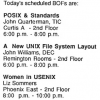USENIX supports diversity, equity, and inclusion and condemns hate and discrimination.
From the Vault: Steve Jobs Keynotes 1987 USENIX ATC
In our /etc/motd newsletter, which the USENIX Board of Directors put out, we wrote:
Jobs' Keynote To Target "Invisibility"The Jobs keynote address isn't the only cool bit of history that stood out in our newsletter that day. We had this note at the bottom:Program Chair Eric Allman will introduce one of the computer industry's most illustrious personalities [in] the morning, when Steven P. Jobs takes the podium to speak on "Why We have To Make UNIX Invisible." Remarks begin at 8:30 a.m. in the Ballroom.
Jobs, co-founder of Apple Computer, helped to create the personal computer industry and orchestrated the growth of Apple into a $2 billion company. Jobs co-designed the Apple II and led the development of the Macintosh and the subsequent growth of the Macintosh division into a billion-dollar organization. He was responsible for the LaserWriter and its implementation of PostScript, which helped create the desktop publishing industry.
In September 1985, Jobs, with five others (Susan Kelly Barnes, George L. Crow, Richard Page, Guy L. "Bud" Tribble and Dan'l Lewin) founded NeXT, to build computer products specifically for higher education. According to Jobs, "The company mission is to create breakthrough products for colleges and universities which will help revolutionize learning in the next five years."
Jobs' newest computer product will incorporate the UNIX operating system.
Jobs is also chairman of Pixar, a San Rafael, Calif., company that develops and markets state-of-the art color image processing hardware and software with medical, scientific and educational applications.
Jobs was born Feb. 24, 1955. He graduated from public schools in Santa Clara County, Calif., and attended Reed College. In recognition of his pioneering work in technology, he was awarded the National Technology Medal by President Reagan in February 1985.
UUNET As of last month, the USENIX Association is sponsoring an experiment in distributing news and mail. Called UUNET, the system consists of a Sequent Balance 21000 connected to Tymnet via a high-speed leased line.
From the UUNET Wikipedia page:
With funding in the form of a loan from Usenix, UUNET Communications Services began operations in 1987 as a non-profit corporation providing Usenet feeds, E-mail exchange and access to a large repository of software source code and related information. The venture proved successful and shed its non-profit status within two years. At the same time, the company changed its name to UUNET Technologies. In 1990, UUNET launched its AlterNet service, which provided access to an IP backbone independent of the constraints of those operated by the government. That network lives on in a much larger form and serves as the core of a set of products which include access at dial-up and broadband speeds as well as web hosting.
In the mid 1990s, UUNET was the fastest-growing ISP, outpacing MCI and Sprint. At its peak, Internet traffic was doubling every few months, which translates to 10x growth each year. The public disclosures of this growth substantially fueled the expectations of the dot.com and telecom companies of the late 1990s, leading to the dot-com bubble and crash in 2000/2001.
Were you a part of our experiment, which turned out to be the first commercial Internet service provider? If so, what do you remember about it?
As if this one little USENIX newsletter wasn't already full of cool, check out this Tuesday BOF schedule for the 1987 ATC event:- POSIX & Standards
- A New UNIX File System Layout
- Women In USENIX
If you have memories from the 1987 ATC event or other past USENIX conferences, please let us know about them in the comments or email them to us. Or if you're at USENIX Federated Conferences Week, I'd love to hear your stories in person.
Additional Links:
Byte article: The NeXT Computer "Steve Jobs' new 'machine for the '90s'"



